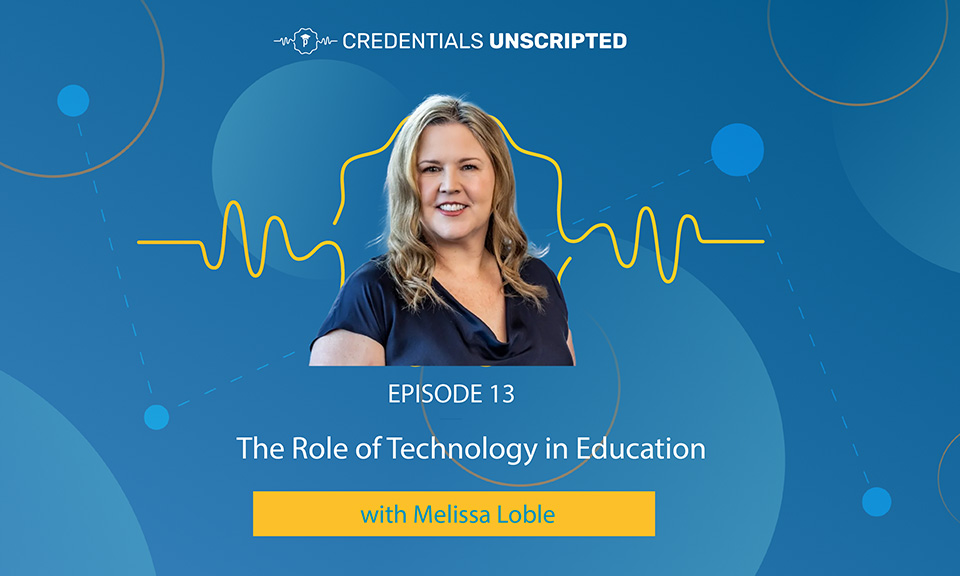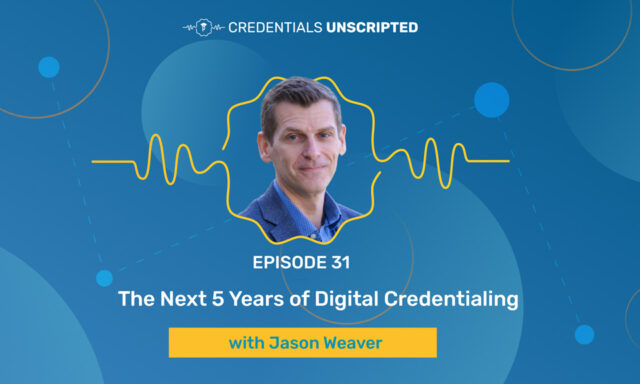Melissa Loble, Chief Academic Officer at Instructure, joins us to discuss the role of technology in education. As educational institutions rely more heavily on EdTech to deliver services to their students, we discuss what it means to be “student-centered” and “customer-centric” as a technology provider. Finally, we attempt to answer the important question: has technology actually made education better?
Transcript
Matthew Sterenberg (00:01.502)
All right, Melissa, welcome to the credentials unscripted podcast.
Melissa Loble (00:06.126)
Thanks for having me. I’m excited to be here.
Matthew Sterenberg (00:09.246)
So Melissa, you’re the chief academic officer at Instructure. And obviously now that Parchment and Instructure are one company, I wanted to have you on because you’ve got a ton of experience in this space and just wanted to get to know you and you’re a bright voice in education. And I wanna get to know you a little bit more. Tell me a little bit about your background.
Melissa Loble (00:31.502)
Sure. And it’s so exciting to have both of these families come together. I think, and I know you’ve dug into this in other podcasts, there’s a lot of opportunity for all of us to come together. But happy to share a little bit about my past. I started in the K -12 classroom and taught public school in New York City and then saw the value that organizations supporting K -12 could play. Did a little bit of nonprofit work in that space and then found myself going back to graduate school and then ending up in higher education supporting educational technology initiatives. Spent a fair amount of time at a number of different universities, NYU, Pepperdine, UC Irvine, while at the same time flirting a bit with the supplier space like we are now and spent some time at another LMS and some other products in the space. So…
I’m an EdTech devotee. My entire career has really been spent focused on educational technology. I’m also in my, I have to think about this, 26th year, I think it’s about 26 years now of teaching online. I’ve always taught online and love to be connected into the space in that way as well, alongside the journey that I’ve had.
Matthew Sterenberg (01:50.494)
What are you teaching? I’m curious. What courses are you teaching?
Melissa Loble (01:52.59)
Yeah. So I teach right now at the University of California Irvine in their certificate program. And it’s focused on interactive e -learning design. It’s a five course program that helps build e -learning designers for, it could be in the education space, it could be corporate design. And my particular course, that interactivity course, we get to focus on things like gamification, socialization, motivation, a little bit of brain theory mixed in. It’s a ton of fun. It’s also a certificate course. And so it’s fun that it is a different context. I’ve taught master’s programs and then undergraduate programs. And it’s fun to be thinking differently in this sort of non -traditional universe. And I also do some badging in my course too, which is a great experimentation.
Matthew Sterenberg (02:43.934)
So that’s really cool that you’re actively involved in all the things. You’re actually a practitioner of the things that you are also talking about in your kind of quote unquote day job, which is you’re getting the experience on the day to day of what these students are actually like and what does it actually mean to deliver content and thinking about curriculum instruction and then what it means for students to actually become credentialed through your programs, which is pretty cool.
Melissa Loble (03:12.302)
Yeah, I love that I get to practice and experiment and even little things where you’re thinking, OK, this might work if I think about teaching and learning in this way. And then you see the reactions. You’re like, oh, no, I need to alter that thinking just a little bit. I mean, yeah, it’s a norm of one class and between 30 and 40 students at any given time. But still, it helps ground some of that experimentation and those ideas I’m grappling with for my rollout and structure.
Matthew Sterenberg (03:40.286)
So you said you were an ed tech devotee. I’m gonna start with kind of a controversial topic. You and I both work for software companies, ed tech. And I was sitting back the other day. Has technology actually made education better? I think we can point to instances where it’s obviously more efficient. Think about virtual learning. There’s certain ways that we can connect with students.
Melissa Loble (03:43.022)
Mm -hmm.
Matthew Sterenberg (04:10.014)
but has it wholly made education better? We certainly have much better technology today, but has education gotten better? I know this is kind of controversial. Like if the answer is no, it’s like, well, what are we doing here? But help me grapple with this big question.
Melissa Loble (04:23.822)
Mm -hmm.
Melissa Loble (04:29.87)
Yes. And I am going to say no, but I’m going to give a caveat to that and why I say no. And it’s a little maybe in how we’re thinking about the question. So I don’t think technology itself has made education better. I think it’s given us different, it’s made it different. We have different delivery options, different ways to permutate. We can bring access to content in a different way than we could in a physical classroom.
What I do think has made education better is the conversations that technology brings in districts, in universities, colleges, even in some of the non -traditional learning environments that we’re starting to see really proliferate. And the question that it brings is it asks an instructor or a teacher or a professor to be reflective about their teaching, as they’re asking themselves, what kind of technology do I want to use, or what am I mandated to use, or how am I going to transform my course to be able to leverage the latest technology? That question, though, how can I do different, and ultimately, how can I do better with the tools in my toolbox, I think is what makes education better. So indirectly, yes, but directly, not necessarily, or no for me. It’s the dialogue, the conversation, the reflection, the experimentation, the change, the technology insights that I think has made education better over the last 20 to 30 years.
Matthew Sterenberg (06:01.598)
I really liked that framing because think about it like we used to have this conversation in admissions. You know, we would talk about, oh, we’ve got this brand new building on campus and everything looks really nice. But ultimately it’s going to be your relationships with professors, for instance, and relationships are really kind of what can change you, right? A building never changed your life. It allows us the opportunity to ask different questions or gives us greater opportunity, but that doesn’t mean it’s like necessary, but not sufficient to put it differently.
Melissa Loble (06:38.574)
Yeah. And we tend to get, I love that analogy because we tend to get caught up in the things we do as opposed to how do we do the things we do. So we get caught up in education and building the new building or in implementing the new technology. And that doesn’t always, if we just do that, we’re not producing the results or the innovation or the change that we’re looking for.
But if we do take the time in the things we do to think about how we’re doing those things, that’s where it can be profound. And so I think without technology, could education be where it is today? No, because we wouldn’t have been prompted in the same way to have the conversations about how do we do what we do to then change what we do. And then we happen to use technology along the way to do that.
Matthew Sterenberg (07:30.142)
Yeah, it’s to what end is always the question, right? And the quote that sticks out to me, actually our CEO, Matt Patinski, the CEO of Parchment brought this up years ago. And it’s a quote by Ralph Waldo Emerson. It’s all of our inventions are but unimproved means, or improved means to unimproved ends. Meaning like we invent the telephone, but our conversations aren’t improved. It just makes it easier to talk.
Melissa Loble (07:32.814)
Mm -hmm. That’s right.
Matthew Sterenberg (07:59.134)
but our conversations aren’t more enlightened, for instance. And so it always, I always think about that, right? All right, we move from paper to digital. We didn’t improve the transcript necessarily, right? But we just made it more efficient. But how do we actually improve the life of a student? How can we create a credentialing system, for instance, that makes it easier to get a job or easier to navigate the educational pathway that I’m on, et cetera. So I really like that framing. I think that’s a good segue into.
Okay, technology gives us this great opportunity. I wanna talk about student -centered thinking. And this is something that you’re thinking about a lot, but what does that actually mean to be student -centered? Because no one would say, we don’t wanna be student -centered. Everyone’s like nodding their heads. Yeah, student -centered’s great. What does it actually mean to be student -centered?
Melissa Loble (08:51.246)
Yeah, I think that’s a really important question for a lot of reasons, because we’ve talked about student -centered learning as an industry for quite a while now. But I’m not sure if we ever stepped back and said, well, what does this really mean? And then how do we evaluate ourselves against our practice, ensuring that if our goal is to be student -centered, that we’re actually achieving that goal?
So student -centered learning, I think of it in two ways. One, I think of it in the traditional pedagogical definition of it’s usually embedded in active learning and the student is owning or proactively engaged in their learning. So, you know, as opposed to passively instructing a learner or passively supporting a learner, it’s a very active experience. But I think the bigger thing about student centered learning, is creating a framework for which we make decisions as educators. So we ask ourselves everything from how do I build my course or what content am I including or how am I going to assess my students by using a student centered lens? Is the student at the center of that activity? Are they encouraged to be proactive in their engagement? Are they part of the decision making of what that experience looks like? That can then that can then enable these different decisions that we make at multiple levels to be focused on that student. And I think sometimes people think, well, is that making the student a consumer? To a certain degree, maybe, but it’s not the same, right? It’s not about putting that student’s decisions or those students’ choices first. It’s about enabling that student to make some decisions or to be part of the decision, to be part of the choice making, to be part of and very active in their learning journey. And sometimes they’ll do things they wouldn’t want to do, or they’ll need to do things they wouldn’t want to do, or things they wouldn’t think of. But the fact that they’re engaged in that dialogue at the center of that learning experience is where the real value is. And then we as institutions, as educators, as teachers, as districts, we need to then be asking ourselves, with that student -centered learning lens, are we?
Melissa Loble (11:11.63)
doing the right things? Are we using the right technologies? Are we building the right ecosystems? Are we creating the right support structure or services structure for students? And the same holds true for any vendors in this space too. Are we building tooling, capabilities, new products, support, you know, access, thinking of that student being part of that choice or decision making process?
Matthew Sterenberg (11:37.022)
Yeah, the question that just popped in my head is, can you be student centered without technology? As we think about the expectations of students changing, I think you could obviously say, you know, a certain context, the answer could be yes, right? But if you think about the holistic experience of a four year institution, for instance, can you really be student centered without thinking about technology and what the expectations of the students are?
I think that can be a difficult thing to, you know, the expectations are different and you have to meet different needs of students. Technology, again, not sufficient, but is maybe necessary to be student centered.
Melissa Loble (12:20.078)
Yeah, I think that’s a really good way, good place to take this because can we do it without technology? In theory, if we want to be true to sort of the pedagogical process, yeah, we can. But the thing that I think student -centered learning, if we’re giving people the ability to be the active participants, we’re giving student agency, if we’re doing that, part of that is access to content, people, resources, services. And if we’re going to continue to serve a really diverse community as educators, you have to have technology because it provides way more access to all of that. You know, everything from you want a guest speaker in your class, it used to be who is in the immediate community that could get two hours off to come on over and lecture in your class or come to your, you know, your K -12 classroom and do an activity.
Now it’s you could access anybody around the world. That’s giving students more access, more opportunity being engaged in an active way in their learning because there’s more availability of what we bring to the table. It’s the same with services. You know, I think about mental health resources. If we need to support students, it used to be, whether it’s in K -12 or higher education, you know, they would go to see someone either.
You know, medical office or the advising or maybe not get any, maybe they go to their instructor in person after class. It’s so different now. There are online resources, opportunities for students to own that challenge that they’re facing or that decision and be able to go act on that and be active in that experience. And technology brings all that to us. So I think it’s way better and we can be much more student centered with technology because of that access.
Matthew Sterenberg (14:17.918)
One of the things that I think Instructure does well, and I’ve seen it at Parchment too, is to not take themselves too seriously and also to have almost like a critical lens of yourself in a way. And I often think about the people that we work with, we are one provider for them. And for good reason, they find value in our products and services, the same with Instructure or Canvas, whatever it may be, but then they have their SIS.
And technology, you want it to be scalable. You want it to be able to be updated and you want to have advancements over time. But what does that mean? A lot of the things that a college has are, or K -12 school district, you’re relying on a company, a vendor, you know, we like to see ourselves as partners in this journey, but a lot of the activities are now done through someone else, right?
Or there’s collaboration and cooperation between school district, school, and this technology partner. And I think that’s one of the biggest changes over the years is that it’s not just a school district relying on themselves to deliver the instruction or whatever it may be. And so I just see this as kind of an interesting challenge of you’re not just an institution of higher ed anymore. You’re also working with all these different partners and
For good reason, again, we’ve seen all the problems if you’ve built your own SIS, like it’s not sustainable over time. It’s like, we can’t update this. There’s only five people on campus that know how to, how this actually works. So there’s good reasons for it. But I also want us to like take our own critical lens of like, there are some serious challenges of working with like for -profit companies that are trying to do this work. I don’t know if you’ve ever thought about it, but I just wanted to kick it out to you. Cause I know you’re really thoughtful about this type of thing. Isn’t that kind of a funny dynamic that we’re living in today?
Melissa Loble (15:56.942)
Mm -hmm.
Melissa Loble (16:18.766)
Yeah, it really is a funny dynamic. It’s like bringing intentions. People have multiple intentions. And you always have this lens of, you want a win -win situation, but at the same time, and you want to be a constant learner. And I hope, I know Parchment is a learning organization. I try very hard to have Instructure be a learning organization.
So in all of that, you’re trying to learn from these exchanges and you’re trying to, I don’t know, to build on sort of the humility of both players or all the players as you’re trying to forge a future that you don’t know. But it is an interesting intersection because we do distinctively have different outcomes. We can all be focused on student success as our end point, but we’re getting at it in different ways.
So it is. You’re so right about not taking ourselves too seriously, too. We have to just be able to step back and realize that. And no, you know what? We’re going to come at this from different ways. But if we come at it with that humility and that learning organization mentality, we can actually accomplish so much more together. I’ll give you an example, too. So I’m the chair of the One of Tech board. And on that board, there are competitors.
There’s publishers that are competitors. There’s LMS that are competitors. We have senior representation. And yet we can come to the table and have very real conversations without our own lens per se of as the organization that we represent, but as the same lens of we need to contribute to the education space in the most meaningful way and come away with some really great ideas and conversations that really no other setting would enable that.
So I think these relationships, we need to encourage these. And I think it’s threefold. It’s vendors and technology, it’s institutions and organizations of education, and it’s industry and the workplace or the broader community. And let’s all come together and shed a little bit of what our viewpoints are, still bring them in our understanding together, but let’s shed some of that. Let’s come with humility and let’s see where we can get together creatively to solve some of the big problems we’re all facing.
Matthew Sterenberg (18:40.958)
I’m glad you brought up, uh, one ed tech and just the importance of interoperability, right? How do we create standards that we can all participate in so that it’s not just one organization owning everything. It’s a matter of how can we actually participate in this different type of ecosystem? And I think it also emphasizes being customer centric, right? That’s ultimately the check, right? Are we providing you value?
Do you like the service that we’re providing and making sure we’re listening to people of what they need. Cause ultimately like we’re, we’re serving you, right? You’re going to tell us whether or not you like what we’re providing. And I think that’s, that’s a huge thing that you focused on in your career as well as being customer centric. What is that? What does that actually mean though? We’ve talked about being student centered. What does being customer centric mean as a company? What does that mean for instruction?
Melissa Loble (19:34.99)
Yeah. Yeah, I think that customer centric piece. So when we were talking about student centered learning earlier, I was I was going to immediately go to customer centric. So my past role at Instructure was as our chief customer experience officer. I’ve done that for the last six years. And one of the first things that I implemented in that role was to have a customer centric viewpoint. So same as with student centered learning, we need to put customers, we need to have a customer lens.
when we’re making our all decisions. And when I say all decisions, I mean everything from how do we onboard our new employees to what foods in our kitchens. I know that sounds crazy, but we just need to be thinking about is this in service of the customer in a meaningful way that we know will be valuable and drive that customer’s outcomes. So it’s not about…
You know, there’s debate. I’ll be a little bit maybe feisty with this. People always say we want to delight the customer. I do not believe that that is the right strategy at the end of the day. I love delighting people. Don’t get me wrong. Would love to do that. But really what we need to do is unlock and enable customers to get to the outcomes that they are seeking. And sometimes you’re not delighted in that process. It’s hard. It’s painful. It’s a struggle. But you get there and you get to your outcomes.
So I think it’s putting that lens, that customer centric, similar to that student centric lens on your decision making. How do you choose the little and the big things so that you are in service of your customers objectives, outcomes, and ultimate success?
Matthew Sterenberg (22:09.278)
So Parchment and Instructure are one company now. Walk us through what people can get excited about and the why behind it all.
Melissa Loble (22:18.51)
So first of all, I’m going to put a personal lens to that parchment and instructor what to get excited about question. Early on in my career, I crossed paths with the parchment CEO, Matt Patinski. He is and has always been somebody I admire in the space. Talk about somebody with a student -centered lens and a customer -centric lens. He is that and then some. And I deeply, I’m excited to have him join our leadership team.
And help shape the future of what we’re doing together. So that’s just a personal excitement moment for me. In fact, I remember as soon as the announcement came out, I immediately was like, I’ve been dying to tell you this. I’m so excited to work with you. On a larger company scale and for our customers, I think we’re really at a cusp in education and thinking about instead of our transactional part in the learning, there’s a lifelong learning.
Shift that’s happening right now and in order to do lifelong learning in a meaningful way to the learner at the end of the day, to me as an individual, to you as an individual, we need to think not only about what are the teaching and learning experiences along that journey, but also how do we make our own student -centered deterministic choices or how do we own our own learner agency? How do we track how we want to create that lifelong learning journey? How do we path it?
How do we reflect on it, connect the dots of each of those experiences, and then how do we demonstrate it out into all of our communities, whether it’s a professional community, personal community, wherever it might be. So this idea of marrying teaching and learning with pathing, tracking, and demonstrating learning is huge because it’s becoming one in the same. I think about, I mentioned earlier, iBadge in my class. Well, that’s not just about a learning moment or expressing a skill.
But that badge also becomes a reflection moment and a part and a pathway for somebody to make choices about their career and their future. So it’s both, right? It’s teaching and learning and this understanding and demonstrating and reflecting on my skills. So to me, the combination of parchment and instructor together, I mean, two powerhouses in both of those areas, right? Instructure bringing the teaching and learning, parchment in so many ways, bringing the path and tracking and demonstrating learning, that together to me,
Melissa Loble (24:43.758)
serves the lifelong learner in such a more meaningful way. And by having those two companies together, having us together, we’re able to learn from one another, see and grow from different aspects of the educational process, and then ultimately bring more meaning to our joint customers or even the space, even those who aren’t our customers. It allows us to bring more meaning to what does the future of lifelong learning look like.
Matthew Sterenberg (25:13.534)
Administrating learning is so critical and there’s been a huge shift to skills and competencies recently and I Really started to think about this a few months ago when I was talking to someone when they mentioned the degree has been a proxy for You know, you’re equipped qualified or whatever and I was thinking if someone asked me what I learned in college I wouldn’t even know what to say.
I know, what did you learn in college? Like, well, I spent four years there. I know I learned a lot and developed a lot, but what did I actually learn in college and the focus on demonstrating learning so that I as a learner know what I know and can can share that with others and that employers or wherever I go next in my educational pathway, I can easily demonstrate that because for years we’ve just said bachelor’s degree required.
We really don’t know what of a degree means a lot of times. So including the learning outcomes in there, it kind of hits you in the face when you really start to think about it. Like, what do we actually learn in college? You take a course in Latin American history, philosophy 101, but what does that really mean for me? And how is it reflective of how prepared I am for the next step in my educational professional journey, I think is really, really interesting. So Melissa, you also host a podcast.
So what can we expect on the Instructure Cast?
Melissa Loble (26:42.926)
I do.
Melissa Loble (26:49.23)
Yeah, we’re going to be making some changes, some exciting changes. I think we’re about to wrap up our season one and jump into season two. And we’ve really, the Instructure cast of the past has been a combination of some how -tos with technology, particularly Instructure’s technology, maybe some insights into some of the work that we do at Instructure with let’s go out and have conversations with leaders just like yourself, doing really interesting things more broadly in education.
And so you’re going to see probably two strands to our Instructure Cast moving forward. One being that let’s talk about the big topics. Let’s talk about the big challenges and obstacles and even opportunities that we all have as educators. And we’ll be bringing a lot of thought leaders in. We’re going to bring more students in. We’ve had a number of students come and a lot of commentary on let’s get, we need to get perspectives that we don’t normally ask or engage.
And then there’ll still be a strand of the Instructure Cast that will give people on the ground some tips and tricks, some approaches to how they think about using Instructure technologies as well. So keep an eye out for that. We’re going to be launching that with season two, sort of this different approach to how we think about our podcast. And we always welcome feedback, comments, post in any of our socials or at InstructureCast .com. We would love to get more insight into what you all want.
Matthew Sterenberg (28:15.358)
Melissa, thank you so much for joining me.
Melissa Loble (28:17.87)
Thank you for having me, it’s been such a pleasure.




